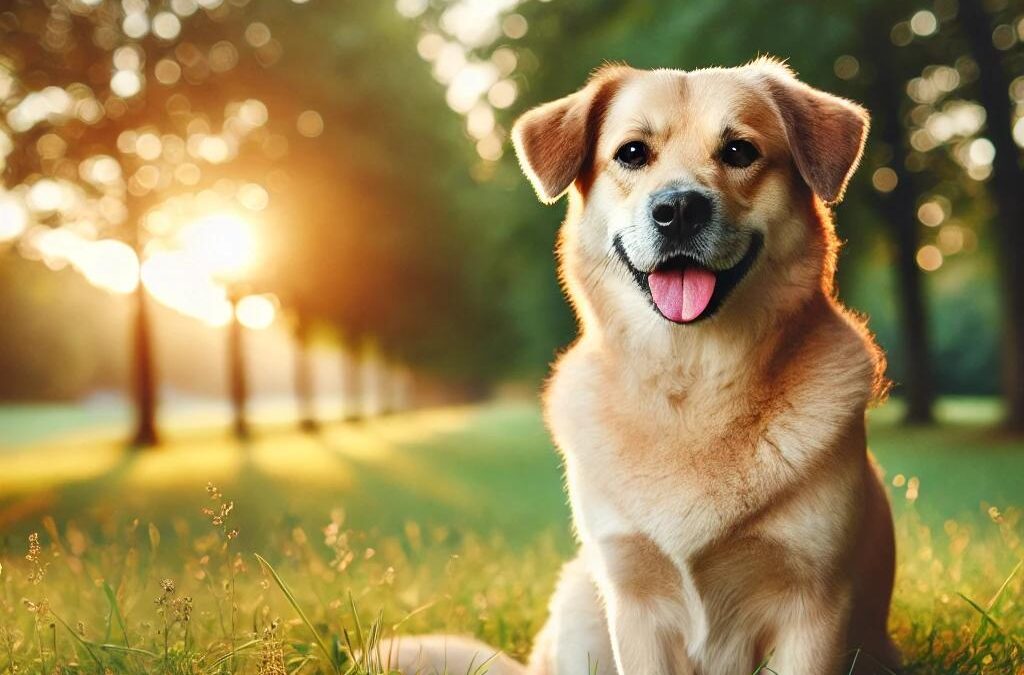
by TCMVET | Oct 28, 2024 | Dog Cancer & Tumors
Tumors originating from the connective tissue surrounding nerves can affect dogs, presenting various symptoms depending on their type and location. Recognizing these growths early and understanding treatment options is crucial for a better prognosis and improving a pet’s quality of life. This article explores common nerve-related tumors in dogs, including amputation neuromas, neurofibromas, and neurofibrosarcomas.
Types of Nerve-Related Tumors in Dogs
- Amputation NeuromasAmputation neuromas are disorganized growths often seen after surgical amputations or traumatic injuries, such as tail docking in dogs. These growths form when nerve tissue begins to heal and reorganize following an injury. Young dogs with docked tails are especially susceptible, often due to repeated irritation of the tail. Owners may notice that their dog frequently licks or bothers the affected area. Thankfully, surgical removal provides a complete cure, offering a straightforward solution for pets with this condition.
- NeurofibromasNeurofibromas are benign tumors that develop in the connective tissue surrounding nerves. They are generally firm, white lumps that remain localized without spreading to other areas. Neurofibromas typically occur in older dogs, causing mild discomfort depending on their location. While these growths are not cancerous, they may still require surgical removal to prevent issues related to nerve compression or local irritation.
- NeurofibrosarcomasNeurofibrosarcomas are the malignant counterpart to neurofibromas and exhibit a similar appearance as white, firm lumps. These tumors tend to be locally invasive, potentially causing nerve pain or affecting nearby tissues. Complete surgical removal is typically the primary treatment for neurofibrosarcomas. Depending on the tumor’s aggressiveness and the extent of local invasion, additional therapies, such as radiation treatment or chemotherapy, may help slow tumor regrowth. This combined approach may extend a dog’s quality of life, though long-term outcomes vary.
Recognizing Symptoms of Nerve-Related Tumors in Dogs
Identifying nerve-related tumors in dogs can be challenging, as symptoms vary by tumor type and location. Here are some key indicators that may suggest the presence of these tumors:
- Unusual lumps or masses under the skin
- Persistent licking or irritation at a surgical or injury site
- Localized pain or discomfort, especially in older dogs
- Weakness or loss of function in a specific limb or area
If any of these symptoms appear, it’s best to consult a veterinarian for an examination and potentially imaging tests, such as X-rays or MRI scans.
Treatment and Management Options
Surgical removal is the most common and effective treatment for nerve-related tumors in dogs. For benign tumors like neurofibromas, surgery alone is often curative. In cases of neurofibrosarcomas, surgery may be combined with radiation or chemotherapy to improve outcomes and reduce the risk of regrowth. Post-surgical follow-ups are important, as they allow vets to monitor for any recurrence and take timely action if necessary.
Preventing and Managing Complications
While some nerve-related tumors, like amputation neuromas, can be associated with trauma or surgical procedures, there is no specific prevention method for neurofibromas or neurofibrosarcomas. Regular veterinary check-ups, especially for senior dogs, can aid early detection and intervention.
Understanding nerve-related tumors in dogs, including amputation neuromas, neurofibromas, and neurofibrosarcomas, is essential for dog owners, especially as pets age. Recognizing symptoms early and exploring surgical and supportive therapies can significantly enhance a pet’s quality of life and offer better outcomes. Consult with a veterinarian to discuss the best approach tailored to your pet’s condition.

by TCMVET | Oct 27, 2024 | pet Chinese herbal medicine
Pheochromocytoma, a rare adrenal gland tumor in cats, requires specialized care, often involving surgery to remove the affected gland. Due to the adrenal gland’s proximity to major blood vessels, the surgery can be challenging. Integrating herbal support with traditional treatments may provide additional comfort and support for cats during recovery. This article covers the surgical process for feline pheochromocytoma, potential post-operative complications, and herbal options to aid in recovery.
Preparing for Surgery: Stabilizing Blood Pressure and Heart Rate
Before surgery, a cat’s blood pressure and heart rate must be stabilized to ensure a safe operation. This is often achieved through medications, sometimes for several weeks prior to surgery. In severe cases, intensive care may be required to closely monitor and regulate these vital signs.
- Medication to Control Symptoms: High blood pressure and elevated heart rates are managed with medications, ensuring that your cat is in optimal health for surgery.
- Pre-Surgical Intensive Care: Cats with critical symptoms may need hospitalization to maintain stable heart and blood pressure rates before surgery, reducing the risk of surgical complications.
The Surgical Process: Removing the Adrenal Gland and Affected Tissues
During surgery, the primary goal is to remove the adrenal gland. However, if the tumor has spread to nearby organs, partial or complete removal of affected tissues may be required:
- Adrenal Gland Removal: The adrenal gland containing the tumor is carefully removed. This step is complex due to nearby large blood vessels.
- Organ Removal if Necessary: If surrounding organs are involved, surgeons may need to remove sections or entire organs to fully address tumor spread.
Herbal Support for Recovery
After surgery, some cats may benefit from herbal support to promote healing and improve overall health. Here are herbs commonly used to assist with recovery and manage post-operative stress:
- Milk Thistle (Silybum marianum): Known for its liver-protective properties, milk thistle may aid in detoxification and support liver function during recovery from anesthesia and medication.
- Reishi Mushroom (Ganoderma lucidum): Reishi mushroom is a well-known adaptogen with immune-boosting properties, helping to reduce stress and inflammation while supporting the immune system in recovery.
- Ashwagandha (Withania somnifera): Ashwagandha may help regulate cortisol levels, improving overall resilience to stress and providing gentle support for adrenal health.
- Turmeric (Curcuma longa): Containing curcumin, turmeric has anti-inflammatory properties that may aid in reducing inflammation around the surgery site and promoting faster healing.
- Ginger (Zingiber officinale): With its anti-nausea and digestive benefits, ginger can help reduce nausea after surgery and improve appetite, which is essential during recovery.
Post-Operative Care and Monitoring
Following surgery, cats are typically kept in intensive care to monitor for complications. Veterinarians will watch for potential issues such as:
- Blood Pressure Fluctuations: High or low blood pressure is common post-surgery, requiring close observation.
- Heart Rate and Rhythm Abnormalities: Regular checks on heart rate and rhythm help prevent complications.
- Respiratory Challenges and Infection Risks: Respiratory issues and post-surgical infections may arise, and veterinarians will monitor for any signs of infection or difficulty breathing.
Long-Term Living and Management
Once your cat returns home, a comfortable, low-stress environment can promote a smooth recovery. Here are some tips for long-term management:
- Quiet Recovery Area: Create a calm, quiet space for your cat to recuperate, avoiding loud noises and unnecessary stress.
- Follow-Up Visits: Regular veterinary visits allow for continuous monitoring and adjustment of any medication or supplements as needed.
- Dietary Adjustments: Your veterinarian may suggest a diet that supports liver health and reduces stress on your cat’s adrenal glands.
Life Expectancy and Quality of Life
Life expectancy after pheochromocytoma surgery varies depending on your cat’s overall health and any concurrent conditions. Some cats go on to live several more years, while others may experience shorter lifespans due to related health challenges. Herbal support and regular veterinary care can help improve quality of life and manage any underlying conditions.
Managing pheochromocytoma in cats is complex but achievable with the right combination of surgical care, herbal support, and careful monitoring. Herbs like milk thistle, reishi mushroom, and turmeric can aid in recovery, complementing the effects of surgery by supporting immune health and reducing inflammation. Partnering with your veterinarian for both conventional and herbal treatments can provide your cat with the best possible care.

by TCMVET | Oct 27, 2024 | Cat Cancer & Tumors
Pheochromocytoma, a rare adrenal gland tumor in cats, leads to an overproduction of hormones that can cause elevated blood pressure and increased heart rate. The preferred treatment is surgical removal of the affected adrenal gland, but the surgery is complex due to the gland’s location near major blood vessels. This article explores the surgical process for feline pheochromocytoma, the potential challenges during and after surgery, and effective post-operative care practices for cat owners.
What is Pheochromocytoma?
Pheochromocytoma is a tumor in the adrenal gland, which is responsible for producing hormones like adrenaline and noradrenaline. When this gland is affected, it can lead to intermittent surges in these hormones, causing symptoms like rapid heartbeat, high blood pressure, and periods of restlessness in cats. Managing these symptoms often requires surgical intervention, particularly if the tumor is causing health complications.
Pre-Surgical Preparation: Stabilizing Vital Signs
Before surgery, it’s crucial to stabilize the cat’s heart rate and blood pressure to ensure safe surgery conditions. Here’s how veterinarians typically manage this process:
- Medication for Heart Rate and Blood Pressure: Cats with pheochromocytoma often receive medications to lower their heart rate and blood pressure. This may take several weeks of treatment before surgery is deemed safe.
- Intensive Care for Severe Cases: In cats with dangerously high blood pressure, intensive care may be necessary to stabilize their condition before surgery. This close monitoring helps ensure the best possible outcome.
Surgical Procedure for Adrenal Gland Removal
The surgery to remove an adrenal gland with a pheochromocytoma is challenging, primarily because the gland is located near major blood vessels. The main objectives during surgery are:
- Tumor Removal: The affected adrenal gland is carefully removed to eliminate the primary source of excessive hormone production.
- Addressing Spread to Other Organs: If the tumor has metastasized, partial or complete removal of nearby organs may be necessary, depending on the extent of the spread.
Post-Surgery Care: Monitoring and Recovery
Post-surgical recovery is crucial for cats with pheochromocytoma due to the risk of complications. Here’s what post-operative care involves:
- Intensive Monitoring for Complications: Blood pressure, heart rate, and respiratory function are closely observed. Complications like bleeding, blood pressure fluctuations, and respiratory issues are common, so close monitoring is essential.
- Pain Management: After surgery, cats receive medications to manage pain and reduce discomfort during recovery. Veterinarians carefully monitor their response to ensure proper pain relief.
- Observation for Infections: Post-operative infections can occur, so veterinarians monitor for any signs of infection, including fever or swelling.
At-Home Recovery and Long-Term Care
Once your cat returns home, it will need time to adjust and gradually regain its strength. Here’s how to create an optimal recovery environment:
- Provide a Quiet Space: Minimize stress and activity to support a peaceful recovery. A calm environment helps prevent unnecessary stress on your cat’s heart and blood pressure.
- Follow-Up Vet Visits: Regular check-ups are essential to monitor for any signs of recurrence or secondary health issues.
- Dietary Adjustments: Your veterinarian may recommend a specific diet that supports recovery, especially if there were complications involving other organs.
Prognosis and Life Expectancy
The prognosis for cats with pheochromocytoma depends on factors like tumor spread, surgical success, and overall health. While some cats recover and go on to live several years after surgery, others may face shorter life expectancies if additional health issues are present. Your veterinarian will guide you in understanding your cat’s individual outlook.
Pheochromocytoma in cats is a challenging condition, but with skilled surgical intervention and careful post-operative care, many cats experience improved health and a better quality of life. By understanding the steps involved in the treatment process and following your veterinarian’s care guidelines, you can help your cat recover successfully from this complex condition.

by TCMVET | Oct 27, 2024 | Cat Cancer & Tumors
Pheochromocytoma, a rare tumor of the adrenal gland, can cause intermittent spikes in hormone levels, leading to sudden changes in heart rate, blood pressure, and behavior in cats. Primarily affecting older cats, this tumor originates in the adrenal glands above the kidneys, which play a key role in hormone regulation. This article will explore how to identify pheochromocytoma symptoms in cats, effective diagnostic methods, and natural care options to help improve your cat’s quality of life.
Recognizing Symptoms of Pheochromocytoma
Pheochromocytoma’s hallmark is its intermittent symptoms, caused by the unpredictable release of hormones like adrenaline. Here are some common signs to look out for:
- Elevated Heart Rate and Blood Pressure: Spikes in heart rate and blood pressure can cause your cat to act unusually energetic or anxious during these episodes.
- Rapid Breathing: During hormone surges, cats may breathe more quickly or appear agitated.
- Periods of Nervousness or Agitation: Hormone fluctuations may leave your cat looking stressed or uneasy, even in calm environments.
- Changes in Appetite or Weight: Although less common, some cats may show changes in appetite or slight weight fluctuations due to metabolic impacts.
Diagnosing Pheochromocytoma in Cats
Accurate diagnosis of pheochromocytoma is essential to differentiate it from other health conditions that could cause similar symptoms. Veterinarians typically perform:
- Blood Tests: These tests may reveal abnormal hormone levels, suggesting adrenal gland issues.
- Ultrasound or CT Scans: Imaging can help identify tumors in the adrenal glands or determine if the cancer has spread to other organs.
- Urinalysis: Sometimes, testing the urine can reveal excess hormone levels linked to adrenal issues.
Natural Support Options for Cats with Pheochromocytoma
While medical interventions like surgery or medication may be necessary for managing pheochromocytoma, certain natural approaches can help improve your cat’s comfort and overall health:
- Ashwagandha (Withania somnifera): This adaptogenic herb helps regulate stress and may support hormone balance, which can be helpful for cats with adrenal gland irregularities. Ashwagandha can also improve energy levels and provide calming effects.
- Reishi Mushroom (Ganoderma lucidum): Known for its immune-boosting and anti-inflammatory properties, reishi mushroom can help manage inflammation and provide immune support, which may benefit cats dealing with tumors.
- Turmeric (Curcuma longa): Curcumin, the active compound in turmeric, has antioxidant and anti-inflammatory effects that can support adrenal health. Turmeric may also help improve liver function, essential when managing hormone-related issues.
- Valerian Root (Valeriana officinalis): Known for its calming properties, valerian root may help reduce restlessness and anxiety, especially useful during sudden hormone surges.
- Dandelion Root (Taraxacum officinale): This herb supports liver function and may help remove toxins from the body, which can alleviate some strain on the adrenal glands.
Additional Lifestyle Tips for Managing Pheochromocytoma
To help maintain a calm and supportive environment for a cat with pheochromocytoma:
- Create a Stress-Free Space: A quiet, cozy environment can help your cat feel secure and minimize stress, especially during episodes of hormonal imbalance.
- Use Soft Lighting and Relaxing Sounds: Avoid bright lights and loud sounds, which can aggravate agitation. Soft music or calming sounds can help relax your cat.
- Provide Regular, Mild Exercise: While it’s important not to overexert a cat with heart or blood pressure issues, gentle play can help maintain physical health and reduce stress.
Consulting a Veterinarian for a Holistic Approach
When considering natural treatments, consult a veterinarian familiar with integrative medicine. They can advise on proper dosages and any potential interactions between herbs and prescribed medications, ensuring your cat receives a well-rounded care plan.
While pheochromocytoma is a challenging condition, understanding its symptoms and incorporating natural, supportive care can greatly improve a cat’s comfort and quality of life. Herbs like ashwagandha, reishi, and turmeric, combined with a peaceful environment and regular veterinary guidance, can play a significant role in managing pheochromocytoma’s effects and helping your cat lead a fulfilling life.

by TCMVET | Oct 27, 2024 | pet Chinese herbal medicine
Bile duct cancer in cats, also known as bile duct carcinoma, is an aggressive and complex form of liver cancer. Typically affecting senior cats, this cancer originates in the bile ducts within the liver, causing symptoms such as jaundice, abdominal pain, and decreased appetite. Although surgical options are limited due to the high risk of metastasis, a holistic approach that combines natural care and herbal support can help enhance your cat’s quality of life. This article explores herbal and lifestyle strategies that can provide comfort and assist in managing bile duct cancer in cats.
Recognizing Bile Duct Cancer in Cats
Bile duct cancer usually develops in the intrahepatic bile ducts (inside the liver) rather than in the extrahepatic ducts (outside the liver). Its symptoms can be subtle at first, making early detection challenging. Here are some common signs of bile duct carcinoma:
- Jaundice: Yellowing of the eyes, gums, and skin due to bile duct obstruction.
- Weight Loss: Gradual weight loss from reduced appetite and nutrient absorption issues.
- Abdominal Swelling and Pain: Caused by tumor growth and fluid accumulation in the abdomen.
- Fatigue: A lack of energy due to the body’s increased metabolic demands and liver function disruption.
While these symptoms are not unique to bile duct carcinoma, they warrant immediate veterinary consultation, particularly in older cats.
Herbal Supplements for Supporting Liver Health
While herbs cannot replace traditional medical treatments, they can provide supportive care for cats with liver cancer, helping to manage inflammation, support liver function, and promote general wellness.
- Astragalus Root (Astragalus membranaceus): Known for its immune-boosting properties, astragalus is a traditional herb in Chinese medicine often used to support overall vitality. In cats, it may help improve immunity, especially when undergoing treatment for cancer.
- Burdock Root (Arctium lappa): Burdock root has detoxifying properties that support liver and kidney health. It may help flush toxins and reduce liver strain, promoting healthier bile flow.
- Chaga Mushroom (Inonotus obliquus): Chaga is a potent antioxidant and adaptogen known to reduce oxidative stress and support immune function. Its gentle nature makes it suitable for long-term use in supporting cancer care.
- Licorice Root (Glycyrrhiza glabra): Licorice root has anti-inflammatory effects that may help reduce liver inflammation associated with bile duct carcinoma. However, it should be used with caution as it may affect blood pressure.
- Ginger (Zingiber officinale): Known for its digestive benefits, ginger can help stimulate appetite and reduce nausea, making it beneficial for cats experiencing reduced appetite due to liver cancer.
Dietary and Lifestyle Support
In addition to herbal supplements, making adjustments to your cat’s diet and lifestyle can help reduce strain on the liver and improve comfort.
- Liver-Supportive Diet: Feeding a diet with easily digestible proteins, healthy fats, and minimal carbohydrates helps reduce the liver’s workload. Consider incorporating foods high in antioxidants, such as blueberries and broccoli, to combat oxidative stress.
- Regular, Gentle Exercise: Light playtime helps improve circulation and prevent fluid buildup. Avoid strenuous activity, which can be taxing on cats with liver issues.
- Stress Reduction: Minimizing stress is essential for cats with compromised immune systems. Ensure they have a quiet, cozy space where they feel safe and calm.
Consulting with an Integrative Veterinarian
When managing a complex disease like bile duct cancer, consulting with an integrative veterinarian who understands the benefits of combining conventional treatments with herbal support is beneficial. They can help you craft a customized plan tailored to your cat’s unique needs, ensuring herbs are introduced safely alongside any medications or treatments.
While bile duct carcinoma is a serious and challenging condition, a holistic approach that includes herbal support, dietary adjustments, and gentle exercise can provide comfort and improve quality of life for affected cats. Natural remedies such as astragalus, burdock root, and chaga mushroom can be used alongside conventional treatments to support liver health and enhance immune resilience. By prioritizing your cat’s comfort and working closely with a trusted veterinarian, you can provide compassionate and effective care for your feline companion.





